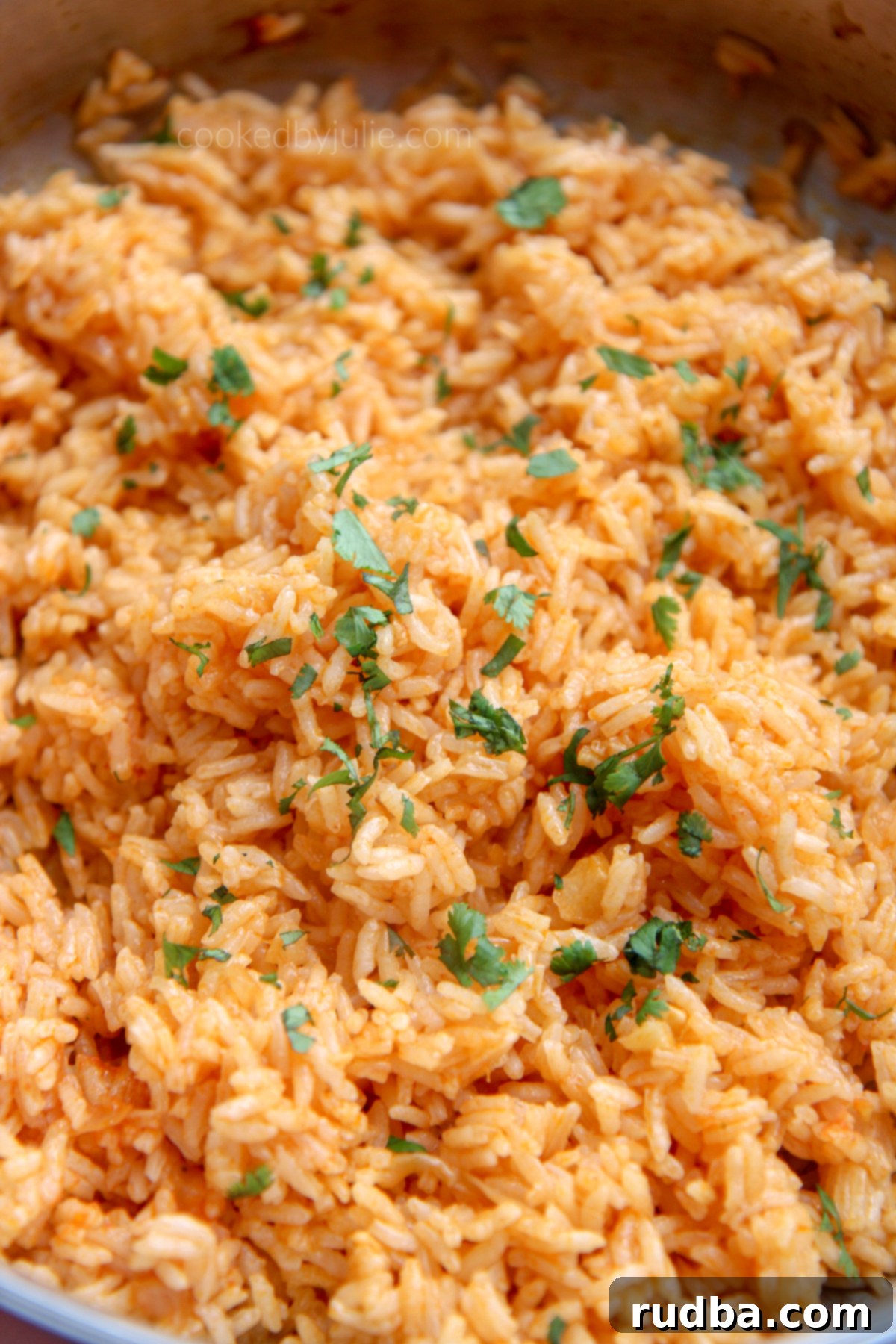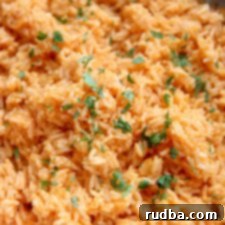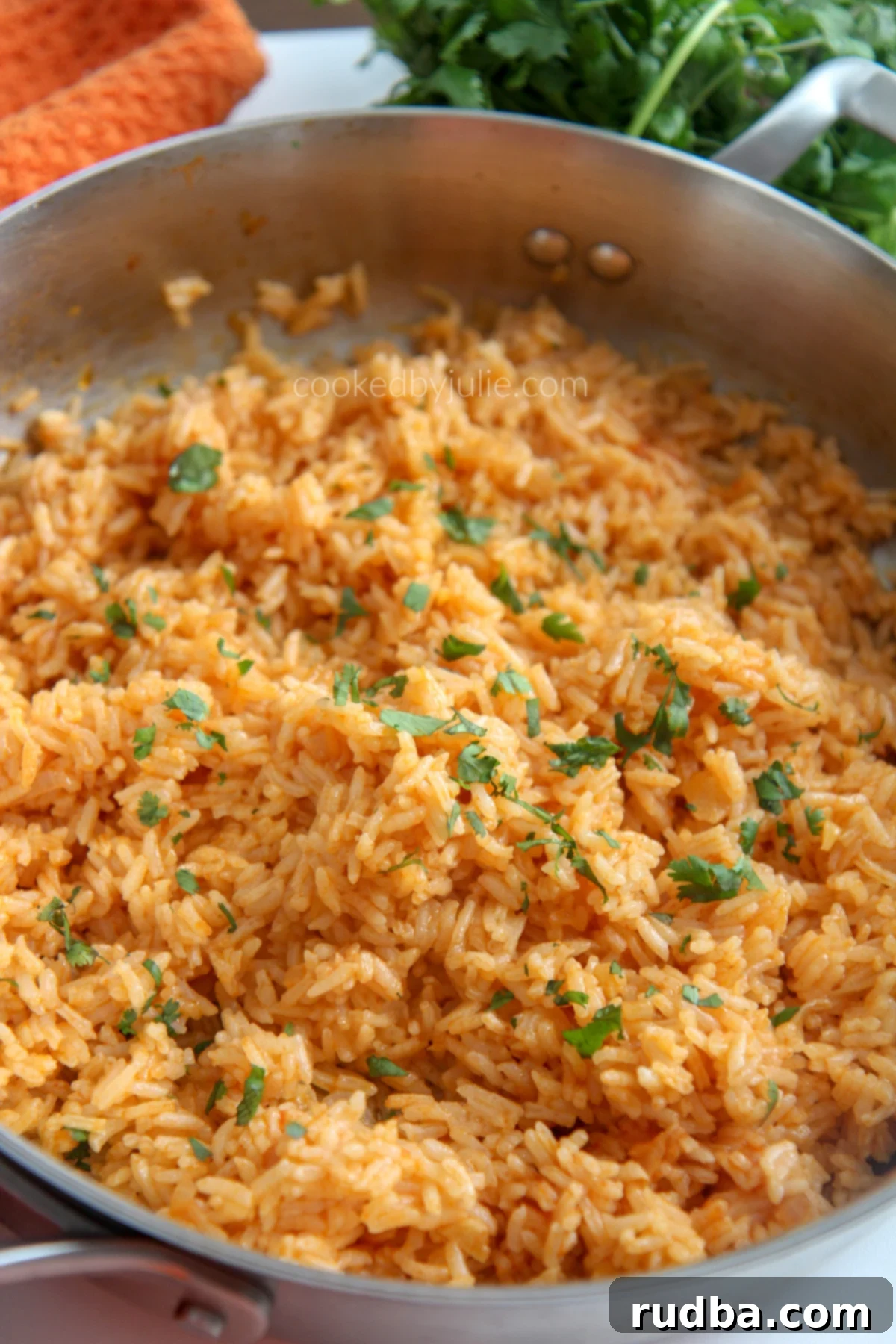Authentic Spanish Rice Recipe: Your Guide to Fluffy, Flavorful Mexican Rice
Dive into the vibrant world of Mexican and Tex-Mex cuisine with this incredibly easy and utterly delicious Spanish Rice recipe. Often referred to as Mexican Rice, this staple side dish is a must-have accompaniment for countless classic meals. Forget complicated steps or lengthy preparation; this one-pot wonder comes together in less than 30 minutes, delivering consistently fluffy and flavorful results every time. Whether you’re serving it alongside hearty Cuban Black Beans, savory Carne con Papas, or cheesy Enchiladas, this recipe promises to elevate your dining experience.
This recipe focuses on simplicity and robust flavor, perfecting the art of a quick, satisfying side. It’s the kind of rice you dream about after a visit to your favorite Mexican restaurant, the one that perfectly balances the rich flavors of tomato, onion, and garlic with perfectly cooked grains. This isn’t just another rice dish; it’s an essential component that ties your entire meal together with its comforting warmth and delightful taste.

The Secret to Perfect Spanish Rice: No Blending Required
Many traditional Spanish rice recipes call for blending onions, tomatoes, and sometimes garlic into a smooth puree before adding them to the rice. While this method can achieve a uniform color and texture, it often introduces too much moisture, leading to a watery or mushy rice that lacks that desirable fluffy consistency. For this recipe, we skip that blending step entirely, opting for a simpler, more effective approach.
Our secret lies in using tomato paste instead of fresh tomatoes. Fresh tomatoes, while flavorful, release a lot of water during cooking, which can make it challenging to get your rice perfectly cooked and separate. Tomato paste, on the other hand, provides concentrated tomato flavor and a beautiful reddish-orange hue without adding excess liquid. This ensures your rice absorbs the exact amount of water it needs to become tender and distinct, not sticky. By sautéing the aromatics (onions and garlic) and tomato paste directly, we build a deeper flavor foundation, allowing the spices to meld perfectly before the rice even hits the pan.
How to Make Spanish Rice: Step-by-Step Perfection
Achieving restaurant-quality Spanish rice at home is incredibly straightforward with this method. It’s a true one-pot process that minimizes cleanup and maximizes flavor. Here’s a detailed breakdown of each step:
- Prepare Your Pan: Start by drizzling about 3 tablespoons of good quality olive oil into a large skillet with high sides. A larger skillet provides more surface area for the rice to cook evenly and prevents overcrowding, which can lead to steaming rather than light sautéing. High sides are essential to keep all the ingredients contained once the water is added and the lid is on, creating the perfect environment for the rice to steam.
- Sauté the Aromatics and Flavor Base: Add the finely diced onions to the hot olive oil. Cook them over medium heat until they become soft and translucent, typically 3-5 minutes. This releases their sweet flavor. Next, stir in the minced garlic and cook for just about 20 seconds until fragrant. Garlic burns quickly, so keep a close eye on it. Immediately follow with the tomato paste, cumin, and chicken bouillon powder (Caldo de Pollo en Polvo). Stir these ingredients constantly for about a minute, allowing the tomato paste to deepen in color and the spices to bloom in the hot oil. This step is crucial for developing a rich, complex flavor base for your rice.
- Toast the Rice: Add 1 cup of long-grain rice to the skillet with the sautéed aromatics and spice mixture. Stir constantly for about 1 minute, allowing the rice grains to get lightly toasted and coated in the flavorful oil. Toasting the rice before adding liquid helps to prevent it from becoming sticky by sealing the outer layer, leading to a fluffier final product. It also adds a subtle nutty depth to the flavor.
- Add Liquid and Bring to a Boil: Pour in 2 cups of water and season generously with salt to taste. Stir everything together well. Increase the heat to high and bring the mixture to a rolling boil. This ensures the rice begins cooking at a high temperature, helping to activate the starch and start the absorption process efficiently.
- Simmer to Perfection: Once the water is boiling vigorously, immediately reduce the heat to the lowest possible setting. Cover the skillet tightly with a lid. It’s vital that the lid forms a good seal to trap the steam. Allow the rice to cook undisturbed for exactly 20 minutes. Resist the urge to lift the lid during this time, as escaping steam will affect the cooking process and can lead to unevenly cooked or sticky rice. The magic happens under that lid!
- Fluff and Serve: After 20 minutes, remove the skillet from the heat and let it rest, still covered, for another 5 minutes. This allows the remaining steam to fully absorb, resulting in perfectly tender grains. Finally, uncover and use a fork to gently fluff the rice. This separates the grains and releases any trapped steam, ensuring a light and airy texture. Serve immediately, garnished with fresh lime and cilantro.

Customizing Your Spanish Rice: Adding Vegetables and More
While delicious on its own, Spanish rice is also incredibly versatile and welcomes the addition of extra vegetables for added nutrition, color, and texture. Absolutely! Incorporating vegetables is a fantastic way to personalize this dish and make it even more wholesome.
Some of the most popular and delicious additions include:
- Corn: Adds a sweet burst of flavor and a lovely texture. You can use frozen or canned corn; add it during the last 5-10 minutes of cooking so it heats through without becoming mushy.
- Carrots: Finely diced carrots provide a touch of sweetness and vibrant color. Add them with the onions so they have enough time to soften.
- Peas: Frozen green peas are a classic addition. Stir them in during the last 5 minutes of cooking or when you fluff the rice.
- Bell Peppers: Diced red or green bell peppers can add a fresh, slightly sweet crunch. Sauté them with the onions for a softer texture, or add them later for more bite.
- Diced Zucchini or Squash: For a healthier touch, add small cubes of zucchini or yellow squash along with the liquid.
To add vegetables, simply sauté heartier vegetables like carrots and bell peppers with the onions. Softer vegetables like peas or corn can be stirred in during the last few minutes of cooking or even after the rice is fully cooked and fluffed, allowing their heat to warm them through. This keeps them from becoming overcooked and mushy. Feel free to experiment with your favorites!
Troubleshooting Common Spanish Rice Problems
Why is my rice so sticky?
Sticky rice is a common frustration, and it usually boils down to a few key factors:
- Too Much Liquid: The most frequent culprit. An excess of water prevents the grains from fully separating, resulting in a gummy texture. Always measure your water carefully.
- Overcooking: Cooking the rice for too long or at too high a heat can break down the starch in the grains, causing them to stick together. Stick to the recommended cooking time and avoid lifting the lid.
- Incorrect Rice Type: While this recipe specifically calls for long-grain rice, using short-grain or medium-grain rice will naturally result in a stickier texture due to their higher starch content. Basmati rice is also not recommended for Spanish rice.
- Stirring During Cooking: Once the lid is on, resist the urge to stir! Stirring releases starch and disrupts the steaming process, leading to sticky rice.
To prevent sticky rice, ensure you follow the exact water-to-rice ratio (2:1 for this recipe), maintain a low simmer, and allow the rice to rest after cooking. Gently fluffing with a fork, rather than stirring, will help separate the grains.
What if my rice is undercooked or too firm?
If your rice is still too firm after the recommended cooking time and resting, it might be due to not enough liquid or the lid not being sealed tightly enough. Add a tablespoon or two of hot water, cover the pan tightly, and cook on very low heat for another 5 minutes. The key is to add minimal liquid and allow the steam to finish the job.
Why doesn’t my Spanish rice have enough flavor?
If your rice tastes bland, it could be a lack of seasoning, especially salt. Always taste and adjust salt before covering the rice to cook. Also, ensuring the tomato paste and spices are properly bloomed in oil at the beginning is crucial for deep flavor development. Don’t rush the sautéing steps!
I’ve experimented with various additions, including salsa and taco seasoning, but found that sometimes the simplest approach yields the most authentic and satisfying results. Those ingredients can often overpower the delicate balance of flavors that define classic Spanish rice. Instead, focus on fresh, high-quality ingredients and the fundamental spices to truly let the rice shine.
However, there are two fresh ingredients that are almost mandatory for serving: fresh lime and fresh cilantro. A fresh squeeze of lime juice brightens up the entire dish with its zesty tang, cutting through the richness and adding a vibrant finish. Finely chopped fresh cilantro, sprinkled generously over the hot rice just before serving, provides a burst of herbaceous freshness and a beautiful green garnish. These simple additions elevate the rice from a good side dish to an unforgettable culinary experience.
Serving Suggestions: What Pairs Best with Spanish Rice?
Spanish rice is the quintessential side dish that complements almost any Mexican or Tex-Mex main course. Its mild yet flavorful profile makes it incredibly versatile, enhancing rather than overpowering your main dish. Here are some of our favorite pairings:
- Tacos and Burritos: Whether you’re making Carne Asada Tacos, chicken tacos, or vegetarian burritos, a scoop of Spanish rice on the side (or even inside!) adds substance and flavor.
- Enchiladas and Fajitas: The rich, saucy goodness of enchiladas or sizzling fajitas finds its perfect match in fluffy Spanish rice, which soaks up all the delicious juices. Try it with Shredded Beef Enchiladas for a truly satisfying meal.
- Grilled Meats: Simple grilled chicken, steak, or pork chops are wonderfully complemented by the flavors of this rice.
- Beans: A classic combination! Pair Spanish rice with black beans, pinto beans, or refried beans for a hearty and traditional meal.
- Stewed Dishes: Dishes like Carne con Papas (Cuban Beef Stew with Potatoes) benefit from the rice acting as a canvas for the rich sauce.
- Eggs: For a unique breakfast or brunch, serve Spanish rice with fried eggs and a dollop of salsa.
Don’t forget the fresh garnishes like a squeeze of lime juice and a sprinkle of chopped cilantro to brighten up every serving!
Storage and Reheating Tips
Leftover Spanish rice is just as delicious, making it a great option for meal prep. Here’s how to store and reheat it:
- Storage: Allow the rice to cool completely before transferring it to an airtight container. Store in the refrigerator for up to 3-4 days. For longer storage, you can freeze Spanish rice for up to 3 months. Portion it out into freezer-safe bags or containers before freezing.
- Reheating:
- Microwave: For individual portions, place the rice in a microwave-safe bowl. Add a tablespoon or two of water or broth, cover loosely, and microwave on high for 1-2 minutes, stirring halfway through, until heated through.
- Stovetop: For larger quantities, transfer the rice to a skillet. Add a splash of water or broth, cover, and heat over low heat, stirring occasionally, until warmed through. The added liquid helps to rehydrate the rice and prevent it from drying out.
Frequently Asked Questions (FAQ)
Here are answers to some common questions about making Spanish rice:
- What is the difference between Spanish Rice and Mexican Rice?
The terms “Spanish Rice” and “Mexican Rice” are often used interchangeably, especially in the United States and Canada. Both refer to a rice dish cooked with tomatoes, onions, and spices, resulting in a reddish-orange color. Historically, Spanish rice in Spain (like paella) is quite different, often using saffron for color and a variety of seafood or meats. The version common in North American “Mexican” or “Tex-Mex” restaurants is more accurately called Mexican rice or Arroz Rojo (red rice) and is what this recipe prepares.
- Can I use brown rice?
While possible, brown rice requires more liquid and a longer cooking time (often 40-50 minutes) due to its outer bran layer. The flavor and texture will also be different. For the best results with this recipe, stick to long-grain white rice.
- Is chicken bouillon powder essential?
Chicken bouillon powder (Caldo de Pollo en Polvo) adds a savory depth of flavor that is characteristic of many authentic Mexican rice dishes. While you can substitute with vegetable bouillon or even just broth instead of water, the chicken bouillon truly enhances the taste. If using broth, reduce the salt accordingly.
- Why is it important not to lift the lid while cooking?
Lifting the lid allows steam to escape, which is crucial for cooking the rice evenly and thoroughly. The trapped steam creates a consistent cooking environment. Opening the lid disrupts this and can lead to undercooked, hard, or inconsistent textures.
More Delicious Sides You’ll Enjoy:
If you love easy and flavorful side dishes, be sure to check out these other fantastic recipes that pair well with a variety of main courses:
-
Cheese Garlic Biscuits
-
Creamed Mushrooms
-
Creamy Mashed Potatoes
-
Creamed Corn

Spanish Rice
Save RecipeSaved Recipe
Pin Recipe
Rate Recipe
Print Recipe
Ingredients
- 1 cup long grain rice
- 2 cups water
- 1/4 cup onions
- 2 garlic cloves
- 1 tbsp tomato paste
- 1/4 tsp cumin
- 1 tsp Chicken Bouillon Powder, Caldo de Pollo en Polvo
- 3 tbsp olive oil
- Salt to taste
Instructions
-
Add 3 tbsp of olive oil to a large skillet with high sides.
-
Add the onions and cook until translucent.
-
Stir in the garlic and cook for 20 seconds.
-
Add the tomato paste, chicken bouillon powder, and cumin.
-
Stir in the rice and cook for 1 minute.
-
Add the water, season with salt, and let it come up to a boil.
-
Once it starts boiling, cover, reduce the heat to low, and cook for 20 minutes.
-
20 minutes later, use a fork to fluff the rice and serve immediately.
-
Serve with fresh lime and cilantro.
Video
Notes
Nutrition
Nutrition information is automatically calculated, so should only be used as an approximation.
Additional Info
Like this recipe? Leave a comment below!
